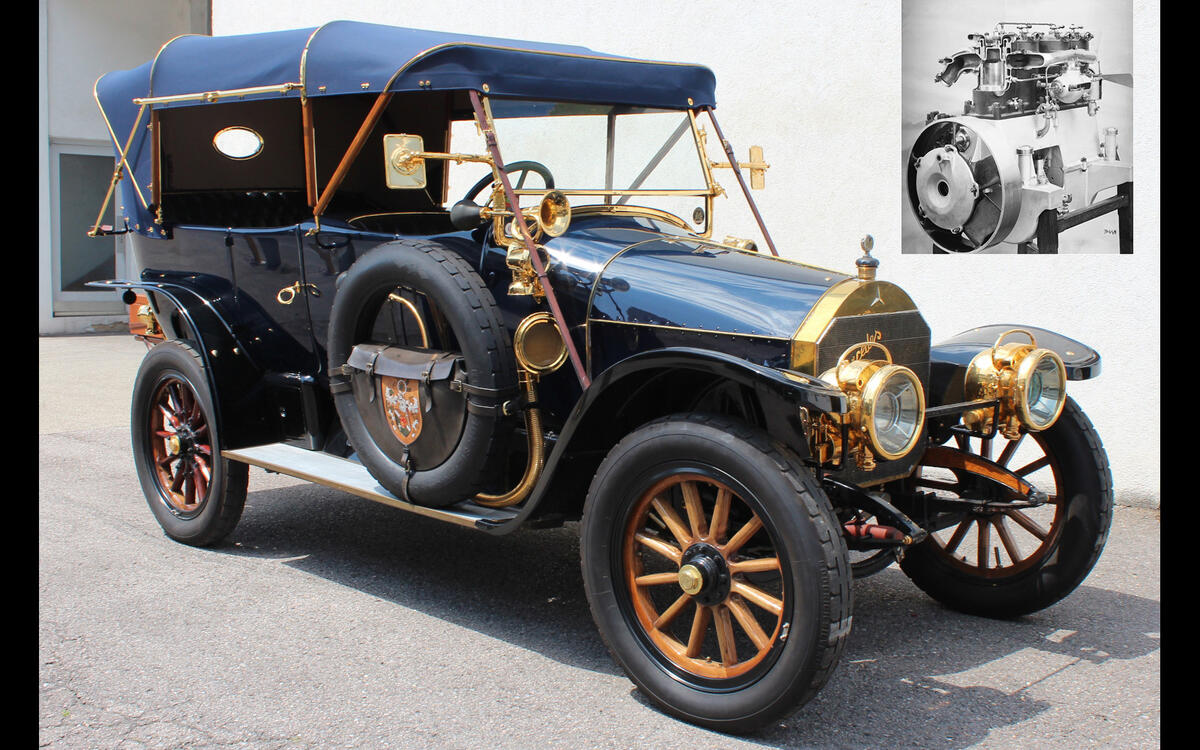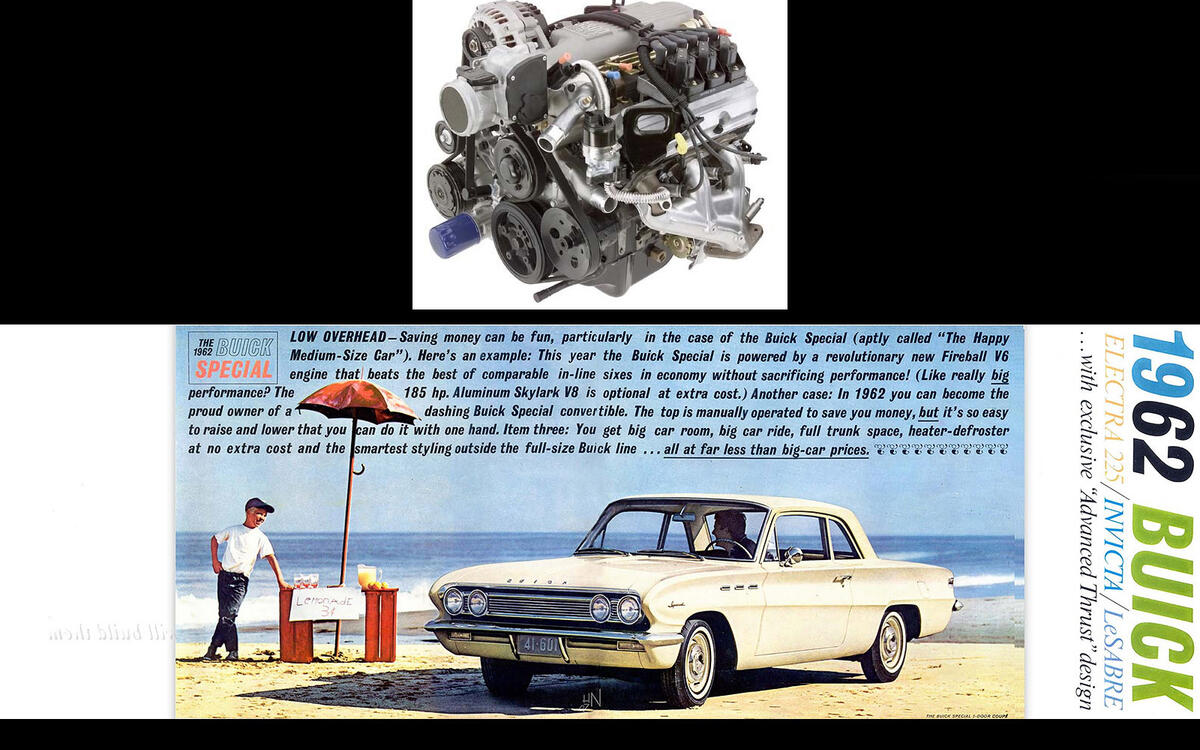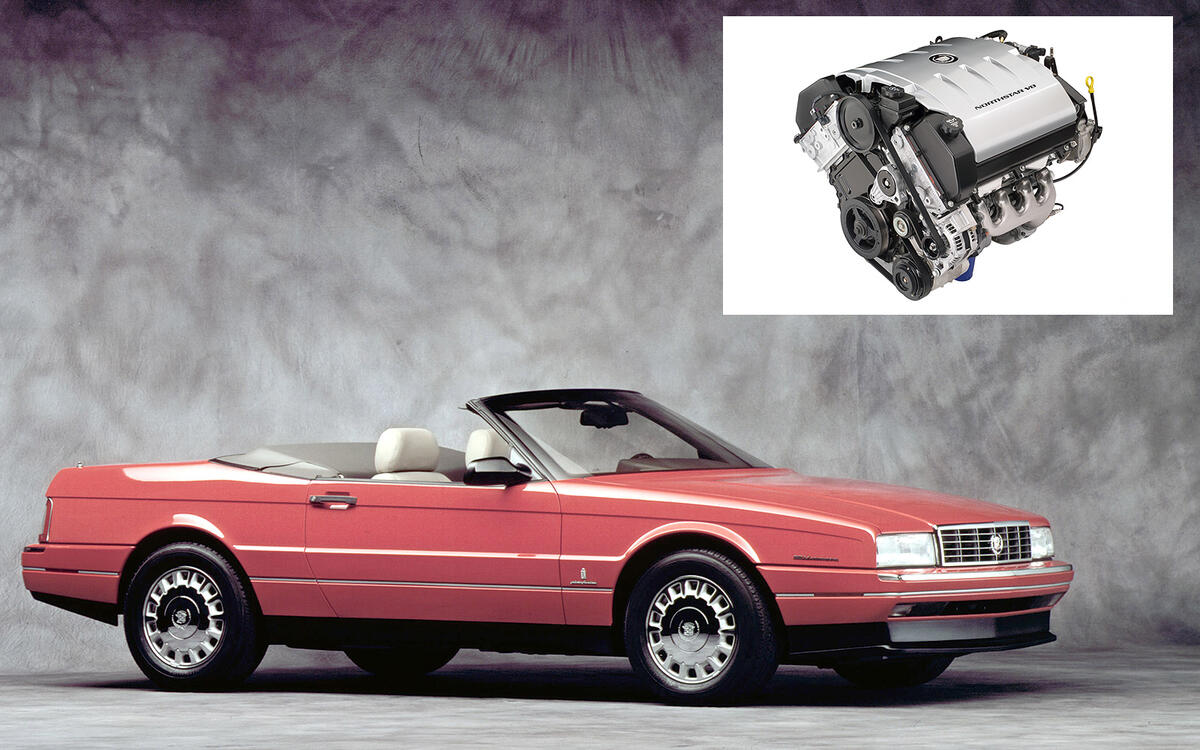 Slide of
Slide of
Cars have been built in North America for a century and a quarter.
For much of that time it was the highest-producing region in the world, and is still second only to China.
It stands to reason that in such a long period of high activity, American manufacturers must have devised many successful, dramatic or imaginative engines. Which one of these has been the greatest can only be a matter of personal opinion, but maybe your favourite is somewhere in the following list, presented in chronological order:
 Slide of
Slide of
Ford Model T
Ford’s 2.9-litre four-cylinder of 1908 could be described as the engine that put Americans on the road by virtue of the fact that it was fitted to the Model T, of which over 15 million were built over 19 years. Notable for its simplicity, the engine was given only minimal development during this period, and never produced more than the original 20bhp.
The engine had far more uses than powering the car it was designed for. Other applications included industrial and marine use, and remarkably it was even used in an aircraft built in the 1930s by the American Bernard Pietenpol (1901-1984).
 Slide of
Slide of
Knight
Indiana’s Charles Yale Knight (1868-1940) developed a sleeve valve engine in the early years of the 20th century. Very efficient and extraordinarily quiet, it principle was taken up by several manufacturers including Voisin in France, Mercedes in Germany (pictured), Daimler in the UK and Willys in the US.
It was one of cleverest American motors ever designed, but by the late 1930s the more conventional poppet valve engine was regarded as superior, and the Knight quietly faded into history.
 Slide of
Slide of
Packard V12
Although the V12 engine dated back to 1904 and a car fitted with one was built in 1908, it wasn’t until 1915 that Packard became the first company to put a V12 car on the market. The Twin Six inspired other luxury manufacturers to produce rival models during a brief period of V12 mania.
In 1921, a Twin Six became the first car ever to take a US President – Warren G. Harding – to his inauguration. By the end of 1923, Harding was dead, the Twin Six was out of production and Americans could, for a while, no longer buy a V12.
 Slide of
Slide of
Chevrolet Stovebolt
Properly speaking, ‘stovebolt’ refers to Chevrolet’s first six-cylinder engine, launched in 1929, and used in cars like this 1932 Chevy Sport Roadster. However, the name is also used colloquially for its replacement, which was built from 1937 until 1963.
The original Stovebolt was marketed as “a six for the price of a four”, no doubt a dig at Ford’s four-cylinder Model A. Its relatively large number of fairly small cylinders gave it a refinement which was not generally available at the time to everyday motorists. For a few years it was the only engine Chevrolet offered for its cars, and it also found a home in the same company’s trucks.
 Slide of
Slide of
Cadillac V16
Of all engine layouts to appear in production cars, the most extravagant is surely the V16. Cadillac was the first to bring one to market in 1930, beating Marmon by a year, and persevered with this 7.4-litre monster through the Great Depression until 1937.
It followed this up with a different 7.1-litre V16 produced from 1938 to 1940. Cadillac is therefore not only the first of a tiny number of manufacturers to offer a V16 for sale – it is also the only one to have done it twice.
 Slide of
Slide of
Ford Flathead
A flathead, or sidevalve, engine is one in which the valves are in the block rather than the cylinder head. The flathead name is also applied to Ford’s first V8, which was introduced in 1932 and rather took the wind out of Chevrolet’s sails three years after the launch of the Stovebolt. A project of Henry Ford (pictured), it is said to be his last major engineering contribution to his company.
An affordable car with a V8 engine (the cheapest model undercut the top-spec four-cylinder Model A) was as sensational in the 1930s as it would be now. The car was so successful that, in the words of British motoring historian Eric Dymock, “casual references to ‘the V8’ habitually meant, ‘the Ford’.”
 Slide of
Slide of
Chrysler FirePower
The FirePower V8 is known retrospectively as the first Hemi engine, since it used a hemispherical combustion chamber. This arrangement, by no means unique to Chrysler, is not without its drawbacks, but it has the advantage of making high power outputs possible.
Introduced for the 1951 model year, it ranged in size from 331 to 392 cubic inches (5.4 to 6.4 litres) and was used to power road cars, racers, drag cars and even an exceptionally loud air raid siren.
 Slide of
Slide of
Buick Nailhead
The V8 engine was already an established part of American motoring life when Buick joined the party. Its first V8s, known as Nailheads and produced from 1953 to 1966, had a design which made it difficult for them to achieve high power, though drag racer Tommy Ivo got round this by fitting four of them to the same car.
The Nailheads were, however, celebrated for their mid-range performance, a quality not always appreciated by those impressed by big numbers. In larger forms of up to 7.0 litres the Nailhead was the standard engine for the first-generation Buick Riviera (pictured) of 1963 to 1965, one of America’s most celebrated cars of the 1960s.
 Slide of
Slide of
Chevrolet Small Block
The outstanding thing about the Chevrolet Small Block V8 is that more than 100 million have been built. It entered the world in 1954 and is still available as a ‘crate’ engine for replacement or high-performance conversions.
Perhaps best known outside North America for powering sporty vehicles such as the Camaro (1985 Iroc Z pictured) the Small Block has also been fitted to everything from trucks to luxury cars and occasionally aircraft. GM also builds a very popular marine version too.
 Slide of
Slide of
Chevrolet Big Block
Successful though the Small Block was from the start, Chevrolet needed something punchier for its larger cars and trucks. The first of the many engines in what has become known as the Big Block family was introduced in 1958.
It was fitted to performance cars such as the Corvette in sizes up to 7.4 litres before the oil crisis of the 1970s got people thinking seriously about fuel economy. Monster engines loosely based on it, though not using Chevrolet parts, have reached sizes of up to 16.5 litres in the case of Sonny Leonard’s formidable Godfather derivative. Perhaps the engine’s most revered placement was in the super-rare 1969 Chevrolet Camaro ZL1 (pictured).
 Slide of
Slide of
Chrysler B and RB
Introduced in 1958 as a replacement for the FirePower (see next slide), the Chrysler B was a big block V8. The RB was the same engine with an even taller block, allowing a 9.6mm increase in piston stroke and overall capacities of up to 440 cubic inches (7.2 litres).
Bs and the even more muscular RBs appeared in many high-output Chrysler products such as the 1970 Dodge Challenger R/T pictured. It also gave foreign manufacturers a chance to offer lots of power without developing their own engines, as in the British Jensen Interceptor and that famous French fancy, the Facel Vega.
 Slide of
Slide of
Ford FE
The FE was a family of V8 engines ranging from 5.4 to 7.0 litres. They were used in many private and commercial Ford vehicles, and in modified form they were found in NASCAR, drag racing and other forms of competition.
Later versions of the AC Cobra used the FE in its larger form, as did the GT40s which won the 1966 and 1967 Le Mans 24 Hours race.
 Slide of
Slide of
Buick V6
The Buick V6 engine made its debut in the Buick Special of 1961 (pictured). Six years later the design was sold to Kaiser-Jeep, which was then bought by AMC, which sold the engine back to General Motors after the oil crisis of the early 1970s.
The V6 was so good that GM continued to produce it - with many updates, of course - until August 2008. Like some other engines - including the Porsche flat-six and the Volkswagen Beetle four - it was on the Ward’s Auto World list of the best engines produced in the 20th century. Its final application was on the last generation examples of the Buick LaCrosse saloon in 2009.
 Slide of
Slide of
Ford Windsor
The Windsor name is used, mostly incorrectly, for a lightweight small-block V8 manufactured from 1962 to 2002. Very widely employed by Ford for its own-brand models, it also found homes in the early AC Cobra, the De Tomaso Mangusta and the Sunbeam Tiger.
Having won the 1966 and 1967 Le Mans 24 Hour races in 7.0-litre FE-powered GT40s, Ford was obliged by a rule change to switch to the smaller-capacity Windsor for the next two years. It made no difference. Ford still won.
 Slide of
Slide of
Chrysler HEMI
Spelled with capital letters, HEMI refers to Chrysler’s current generation of powerful V8 engines. In this case the name refers to tradition rather than design, as the combustion chamber is not hemispherical.
With this engine, in supercharged 6.2-litre SRT Demon form, Chrysler broke through the 800bhp barrier for a standard production car. The 2018 Dodge Challenger (pictured) using it has an output of 808bhp on pump petrol and 840bhp on 100-octane race fuel, and has an official 0-62mph time of 2.1 seconds.
 Slide of
Slide of
Chrysler Hemi 426 ‘Elephant’
The first Chrysler engine officially called Hemi was actually a 426ci (7.0-litre) RB with a hemispherical head. It was developed for NASCAR racing and used in road cars only when the officials made this a condition of it being allowed to compete.
Reportedly, Chrysler built 10,904 examples from 1964 to 1971, some of them fitted to non road-legal versions of the Plymouth Barracuda and Dodge Dart intended specifically for customers to use in drag racing. PICTURE: 1966 Dodge Charger (426 Hemi)
 Slide of
Slide of
Ford 385
Named after its 3.85-inch crankshaft stroke, the 385 was the last Ford big-block V8 of the 20th century. It was introduced in 1968 and used in luxury, performance and police cars including the Ford Thunderbird (pictured) for about a decade until industry-wide concerns about fuel economy led to downsizing.
The 385 held out in trucks until nearly the end of the century, for example being available up to the ninth generation of the F-Series.
 Slide of
Slide of
Ford Cleveland
The Ford V8 engine family officially known as 335 gets its nickname for the Cleveland, Ohio plant where most examples were built. Introduced in 1969 and discontinued 13 years later, it had a much shorter life than the superficially similar Windsor V8.
It did, however, have a starring role in the very desirable 1971 Boss 351 Mustang (pictured). The slightly earlier Boss 302 Mustang had the bottom half of a Windsor engine with Cleveland cylinder heads, which provided superior airflow.
 Slide of
Slide of
Cummins B Series
The B Series is a family of four- and six-cylinder diesel engines first built by Cummins in 1984 and ranging in size from 3.9 to 6.7 litres. They are used in many applications, including the diesel-electric hybrid New Routemaster buses first used in London in February 2012. Cummins also supplies versions for other applications including agriculture and construction.
In the automotive world, these engines are best known for their use in Dodge (later RAM) pickups like this 3500 Club Cab. Delivery drivers Dan Edelman and Donald Jensen bought Dodge Ram 2500 trucks fitted with the B Series in 1996 and 2007 respectively. Both have since exceeded one million miles on the original engine.
 Slide of
Slide of
Ford Modular
The Modular family includes V8s of between 4.6 and 5.8 litres and, for use in trucks, a 6.8-litre V10.
Introduced in 1990, they have powered many Fords, Lincolns and Mercurys, as well as high-performance cars built by Invicta, Koenigsegg, Marcos, MG, Panoz and Rover. Most 21st century versions of the Shelby Mustang, like the 2019 GT350 pictured, have used Modular V8s.
 Slide of
Slide of
GM Northstar
The Northstar was a relatively complex twin overhead camshaft V8 available as a supercharged 4.4 or a naturally-aspirated 4.6. It first appeared in the 1993 Cadillac Allanté, that car’s final model year, and quickly became the only engine used in Cadillacs, while also appearing occasionally in other GM products before being discontinued in 2011 and replaced, for a while, by the less advanced Chevrolet Small Block.
Reports of the Northstar’s reliability vary depending on who you’re talking to (enthuasists tend to say it’s largely a matter of maintenance) but in its day it was impressive enough to appear in the Ward’s Auto World list of best engine every year from 1995 to 1997.
 Slide of
Slide of
Chrysler Viper
The Dodge Viper (also sold as a Chrysler in Europe) had a V10 engine derived from the Chrysler LA family, which appeared in many forms for nearly 40 years. Its capacity started out at 8.0 litres, and as if that wasn’t enough it was gradually increased to 8.4 litres. Power output for production vehicles rose gradually to 645bhp.
Although best known for its use in the Viper, the engine was also used in the Dodge Ram SRT-10 truck, the motorcycle-like Tomahawk concept vehicle, the Alfa Romeo TZ3 Stradale and the very rare Bristol Fighter supercar.
 Slide of
Slide of
Tesla
All Tesla cars have been powered by either one or two electric motors. Whether they can be described as ‘engines’ is a matter for debate, but they are certainly effective, providing nearly silent running and, in the case of the dual-motor Model S P100D, extraordinary performance even though that car has a kerbweight of over 2200kg.
Tesla’s products may or may not show the way forward for the motor industry (there are at least two schools of thought on this subject) but they have unquestionably made their mark, and their motors deserve a place on a list of great American power units.
If you enjoyed this story, sign up to Autocar’s newsletter for all the best car news, reviews and opinion direct to your inbox. Click here to subscribe.
Continuing our occasional series about great car engines, we look at the best ones America has ever produced
Advertisement

















































